This is the result of an independent research by Vietnam Report, built on scientific and objective principles to recognize and honor the key players of the construction industry that have been making every effort to achieve many achievements in providing products to customers, creating an impressive image in the eyes of the public and investors, demonstrating a strong will with stable financial capacity, good resilience when facing difficulties on top of difficulties from the decline in supply in the pre-COVID-19 period, the consequences of the pandemic to the Russia-Ukraine conflict, fluctuations in raw material prices, escalating inflation and sharp increase in interest rates...
Enterprises are filtered from the database of Vietnamese enterprises in Vietnam Report's ranking studies in the construction industry with financial data updated to December 31, 2022, combined with the use of Media Coding method (coding press data on the media), surveying research subjects and stakeholders to provide the most comprehensive, objective and complete assessment of enterprises throughout the recent difficult period, highlighting the following names.
List 1: Top 10 Construction Contractors in 2023
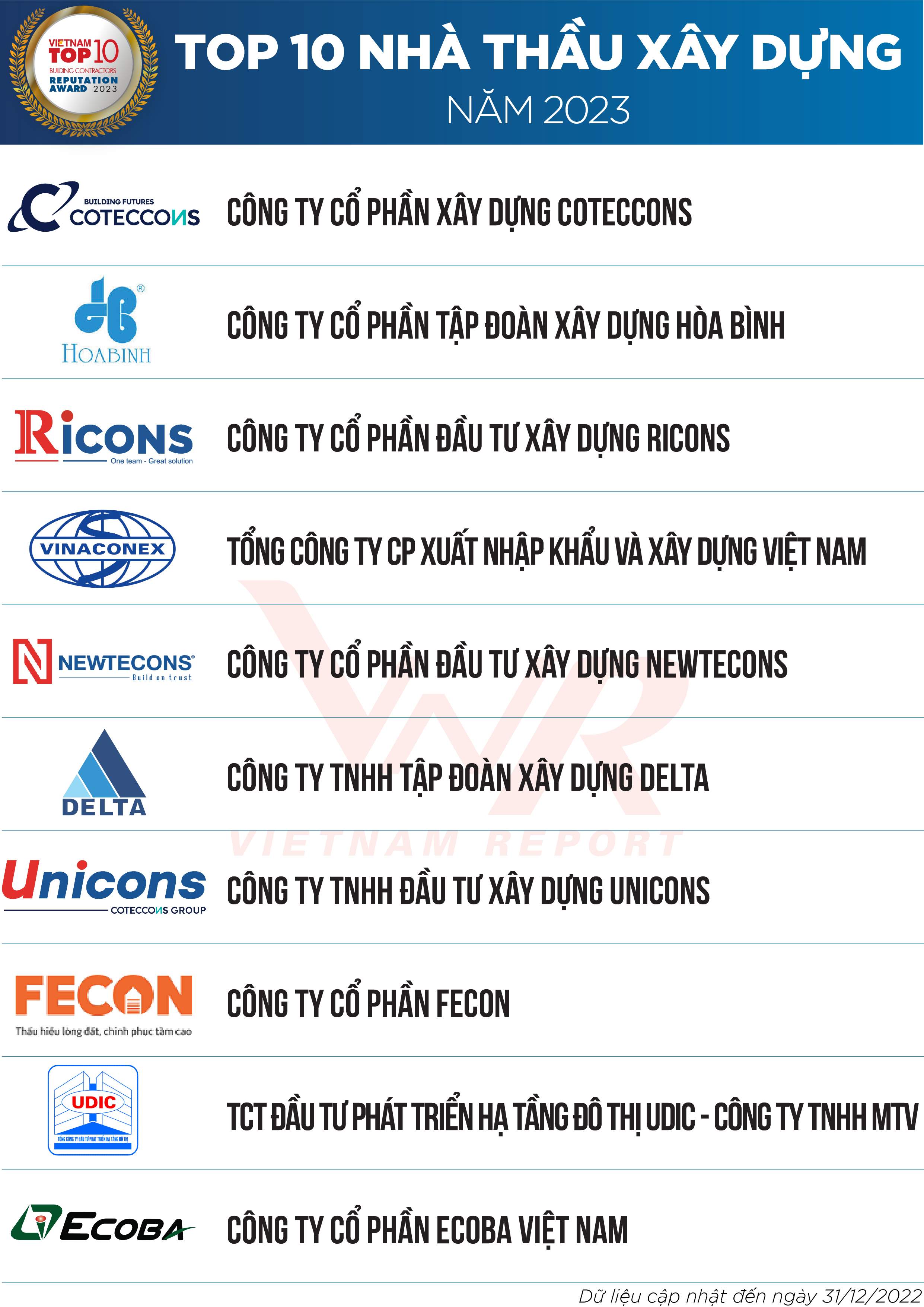
List 2: Top 5 Electromechanical Contractors in 2023
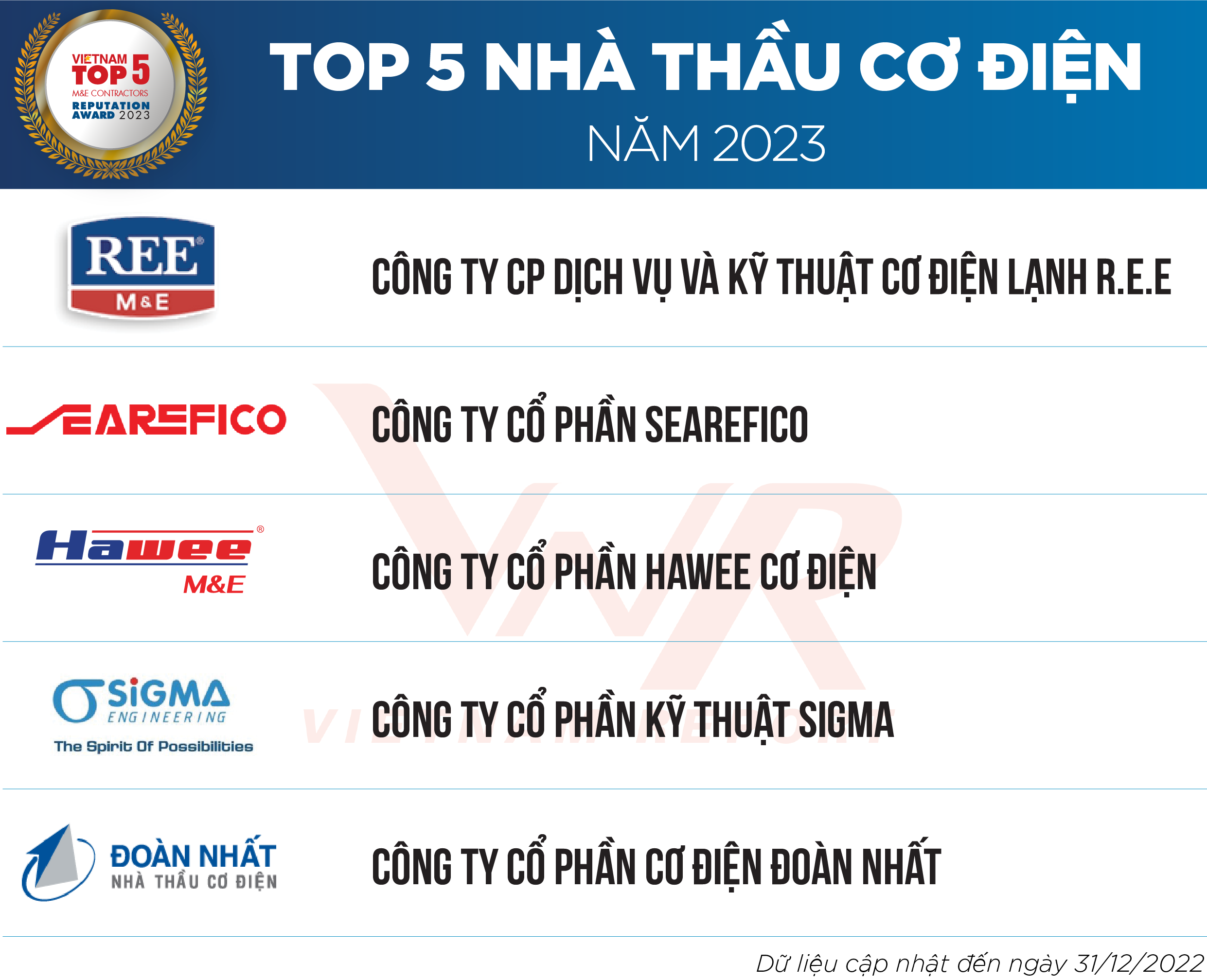
Looking back at the construction market self-screening process over the past 5 years
Figure 1: Growth/decrease rate of added value in the construction industry in the period 2011-2022
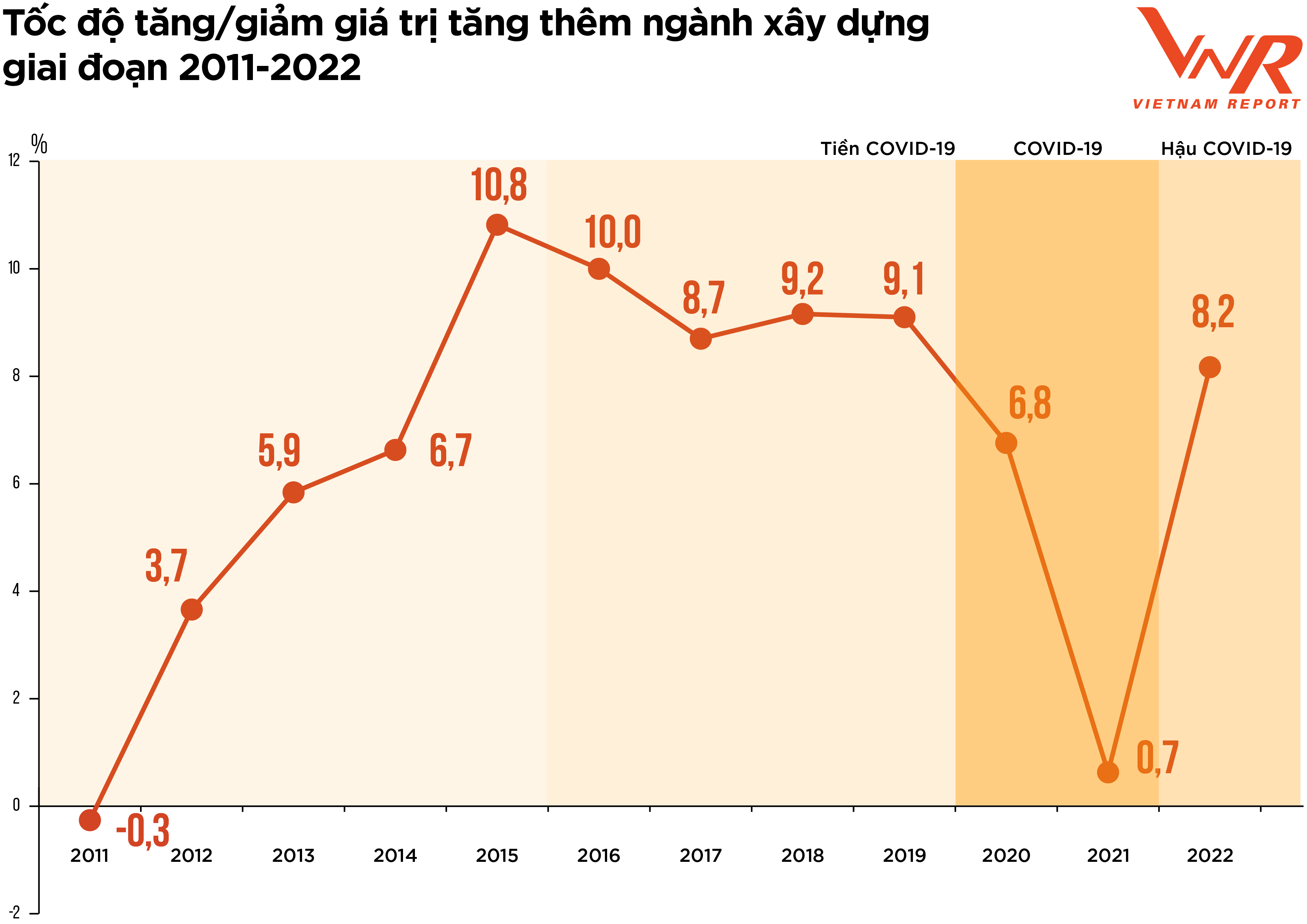
“Screening” or “self-regulation” are the phrases that most clearly reflect the developments in the construction market over the past 5 years after the strong growth period of 2021-2015. In particular, in the first months of 2020, the COVID-19 pandemic was like a “black swan” that disrupted all aspects of economic and social life, pushing the world to move faster into a new economic cycle. Looking back at the market developments over the past time, it can be divided into 3 stages corresponding to the process of responding to the pandemic as follows.
First, the pre-COVID-19 period. After growing very rapidly in 2017-2018, the real estate market in 2019 suddenly "slowed down" mainly due to legal factors. This led to a decrease in the supply of the construction industry, reflected in a significant decrease in the number of approved projects. According to data from the Vietnam Real Estate Association, only 5 projects were eligible for new implementation and approved in Hanoi in 2019. A survey conducted by Vietnam Report in February 2020 showed that 91.4% of construction contractors and electromechanical contractors said that the decrease in the number of approved projects was their top difficulty in 2019.
Second, the COVID-19 period. This is a period associated with disruptions and instability due to the pandemic. Due to the strong outbreak of the pandemic, many localities were forced to implement social distancing, resulting in many projects having to stop construction or being delayed due to disruptions in the supply of materials and human resources. The most visible economic losses are: costs of maintaining the apparatus, costs of epidemic prevention, costs of mobilizing resources after periods of social distancing... 37.9% of enterprises participating in the survey conducted by Vietnam Report in February 2021 said that over 20% of their projects/contracts were behind schedule or affected in cost due to the COVID-19 pandemic. This period also began to record an escalation in construction material prices. The price index of raw materials, fuels and construction materials increased by 6.4% over the same period due to high demand for construction materials while the supply chain has not been disrupted since 2020. Since the cost of construction materials accounts for about 65-70% of the estimated construction cost of a project, the increase in construction material prices directly affects the construction investment cost, the efficiency of many projects, and erodes the profit margin of businesses.
Some industry experts say the “price storm” has wiped out any remaining potential profits, pushing many businesses into losses. According to the General Statistics Office, the industry’s growth rate in 2021 was only 0.63% - a very low rate compared to the average growth of 7.2% over the past 10 years.
Figure 2: Level of completion of the construction business's plan
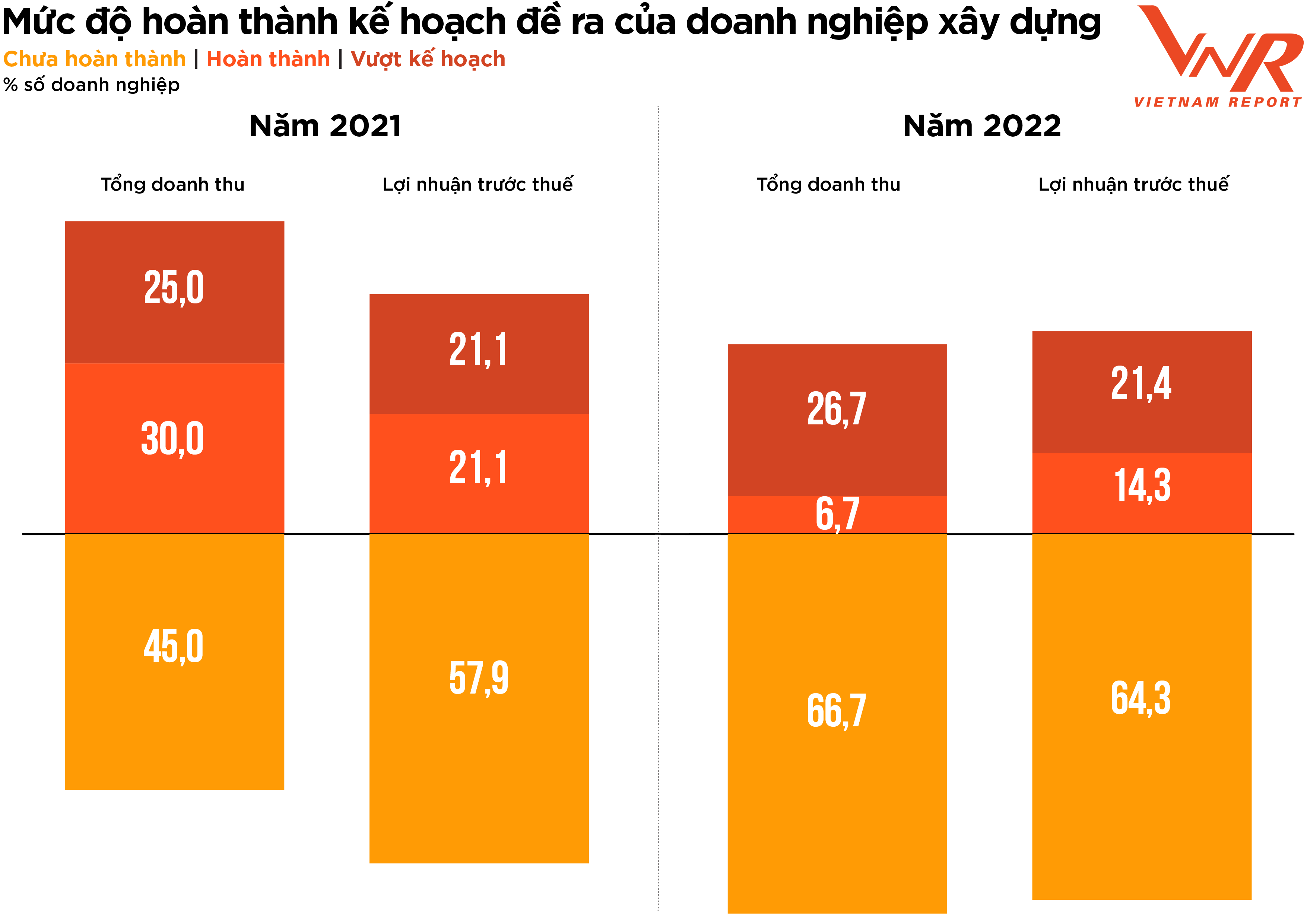
Third, the post-COVID-19 period. After two years of stagnation due to the pandemic, the construction industry entered 2022 with high expectations of recovery. In early 2022, many construction businesses recorded strong growth in the value of signed contracts (backlog) and positive demand for civil construction after the social distancing period. However, immediately after that, consecutive headwinds affected the financial health of businesses in the industry.
First, the Government implemented a series of measures to purify the bond market and tighten credit for real estate, causing the real estate market to fall into a state of frozen liquidity. Because they are all part of the Real Estate - Construction - Construction Materials ecosystem, once the capital flow of investors is blocked, the cash flow of contractors will also stagnate as the unpaid debts of investors pile up day by day. Meanwhile, contractors are still struggling to overcome the increasingly severe price storm.
According to the leaders of some units in the industry, from the time of participating in the bidding until the construction estimate, the price of materials has skyrocketed, even before construction, they know that they are losing money. Some units with stable financial capacity and good resilience can continue to maintain and survive the price storm, while others are forced to withdraw from the bid. According to the survey results of Vietnam Report, 86.7% of construction enterprises said that the total cost increased compared to the previous year, higher than the cost increase rate in the period 2020-2021 (+44.6%). The rate of completion of revenue and profit plans has decreased, while the rate of unfulfilled revenue and profit plans is higher than a year ago.
In the context of general difficulties of the whole economy, the growth rate of added value of the construction industry in 2022 reached 8.17%, although still lower than the growth rate in the pre-COVID-19 period, it improved sharply compared to two years of market stagnation due to the pandemic, thereby contributing 0.59 percentage points to the growth rate of total added value of the whole economy.
The process of screening the market, highlighting the pillars of the construction industry throughout the recent difficult period, is also truly reflected through the media lens. The results of Vietnam Report's media analysis from February 2020 to present show that although business activities are somewhat sluggish due to market fluctuations, the media activities of enterprises in the industry are still very positive, most contractors have a higher frequency of media appearances than previous years. Hoa Binh and Coteccons are still the two contractors that attract the most media. Fecon and Newteccon are contractors with a fairly stable rate of increase in media appearances. (Figure 3)
Figure 3: Contractors featured in the media
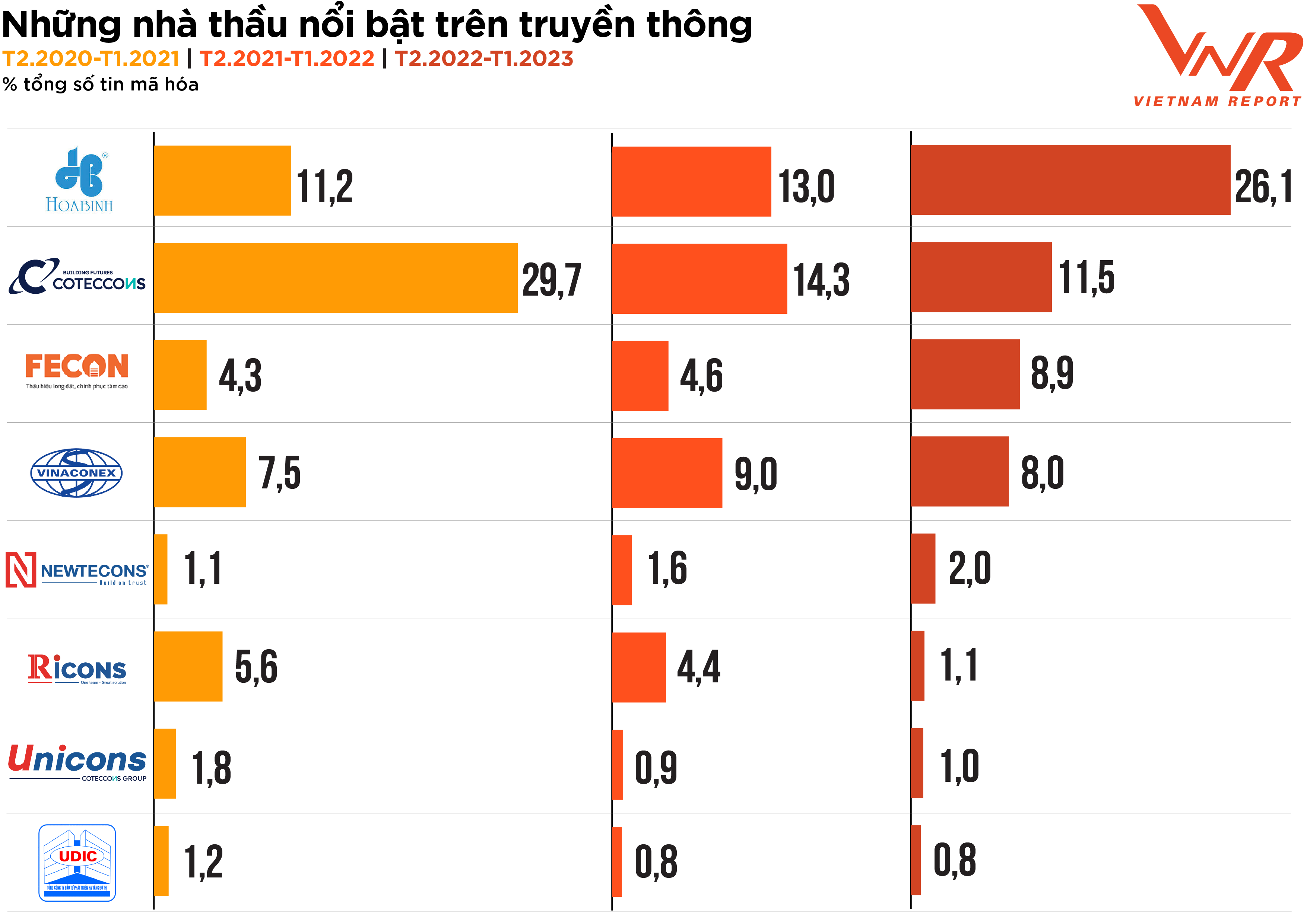
According to Vietnam Report, a business is considered “effective” in terms of image diversity in the media when it has information coverage of 10/24 topic groups and “outstandingly effective” if it has 15/24 topic groups. Media analysis results show that the rate of businesses achieving “effectiveness” in the past year has decreased significantly, reaching only 20.5% compared to 45.1% and 39.1% in the previous 2 years. Of which, Finance/Business Results is the topic that attracts the most media attention with a rate of 21.9%, far surpassing the remaining topics such as Stocks and Image/PR/Scandals. This truly reflects the top concern of the construction industry in a year of many fluctuations, which is the financial health and resilience of businesses.
Figure 4: Rate of encrypted information of construction enterprises classified by information source in the media
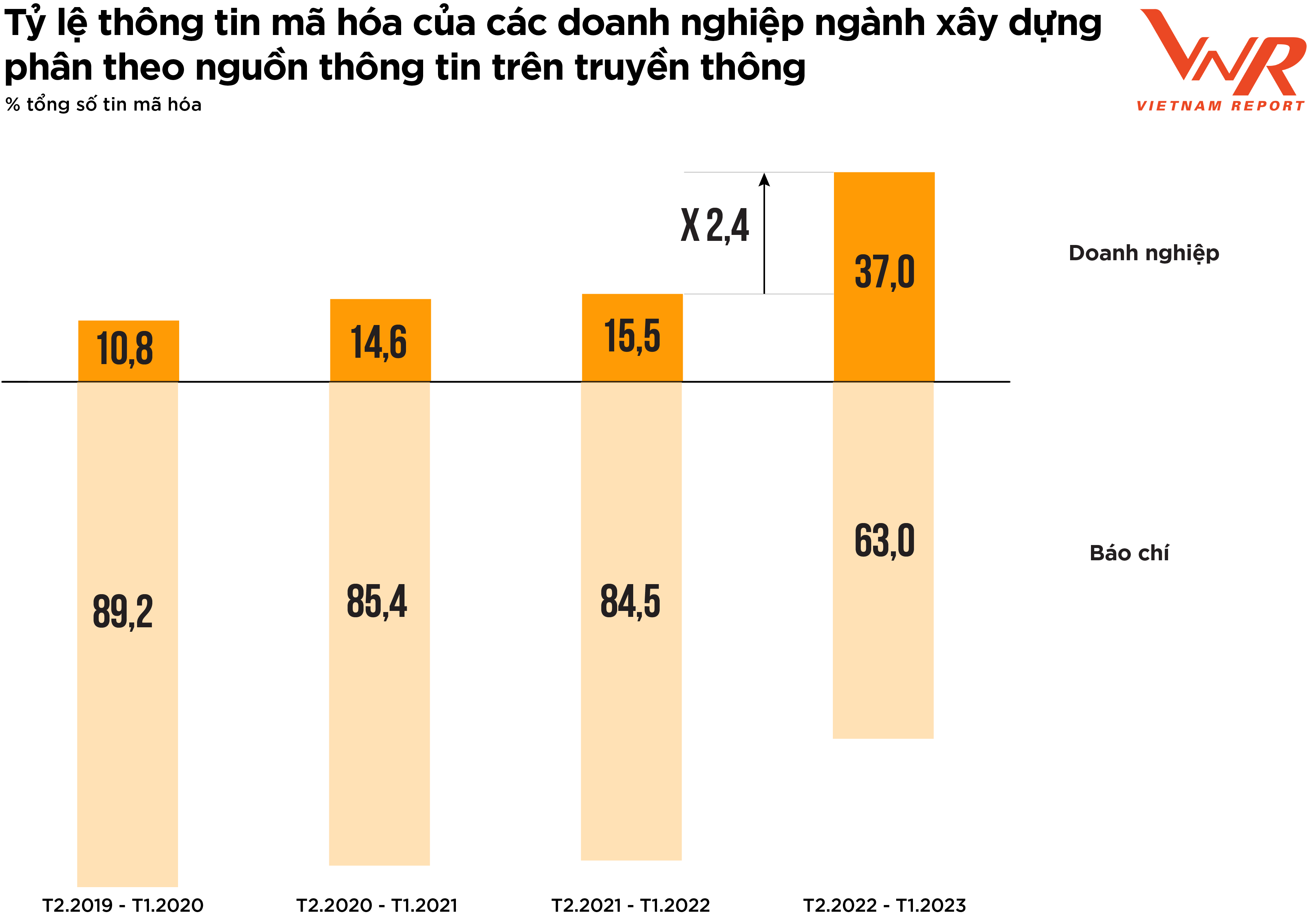
The results of Vietnam Report’s media analysis show a positive sign that businesses in the industry are becoming more active and proactive in their media activities. The rate of news released by businesses in the past year has increased significantly compared to previous periods. (Figure 4).
Previous studies by Vietnam Report have shown that when a business is not proactive in the media and leaves most of its information to the press, it means that the business does not have predictions and response measures for unexpected media incidents that may occur, increasing the level of media risk. In the context of a volatile market, raising one's share of voice in the media is an effective solution to help businesses maintain their image in the eyes of the public and investors.
Outlook for 2023: Proactively overcoming difficulties - Bright spots from infrastructure and industry
Most of the enterprises participating in the survey conducted by Vietnam Report in February 2023 were quite cautious about this year's business prospects. According to the leaders of some large enterprises in the industry, 2023 will still be a very difficult year for contractors because they are under great financial pressure. In terms of the industry value chain, when carrying out construction, construction contractors will receive cash flow from the project investor: (1) Advance payment to the contractor before starting construction of the project; (2) Payment according to the construction progress based on the results of acceptance of completed volume.
However, in reality, general contractors often face the risk of cash flow deficit and have to rely on credit capital for project construction due to three reasons. First, construction costs often have to be paid quite early. Second, cash flow payments from investors are often slow. Third, subcontractors/construction teams are often small in scale and have difficulty accessing credit capital, thus pushing the pressure of cash flow deficit and debt to general contractors. At the time of the survey in February 2023, assessing the ability to access capital, nearly half of construction enterprises said that it would be more difficult than the previous year, but this rate has decreased compared to the survey results a year ago (-25.0%).
Vietnam Report's survey results also show that the proportion of businesses concerned about the impact of the economic recession and the slower licensing and project approval process will continue to increase in the next 12-18 months. Meanwhile, difficulties related to fluctuations in raw material prices, inflation and cautious investment sentiment due to the impact of the pandemic will gradually decrease in impact (Figure 5).
Figure 5: Top difficulties hindering construction industry activities
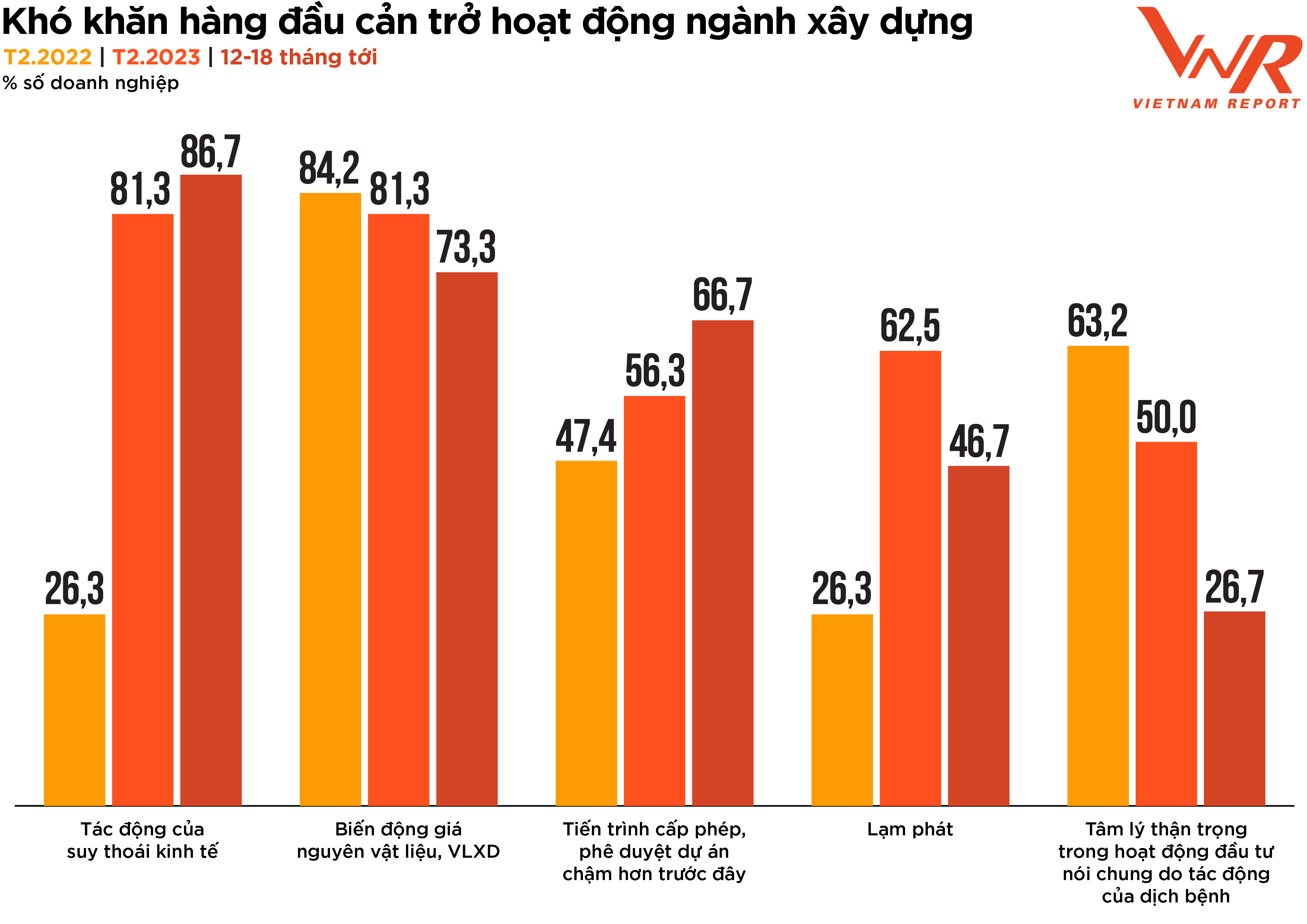
Assessing the investment and business environment of the construction industry, most enterprises are more cautious than last year and there is a strong differentiation between sectors. While two-thirds of enterprises believe that energy and utility construction has not seen many clear changes compared to last year, the majority of enterprises do not view housing and commercial construction positively when construction demand in this segment has not improved and competitive pressure has increased (Figure 6).
Figure 6: Construction enterprises' assessment of the investment and business environment of the construction industry this year compared to last year
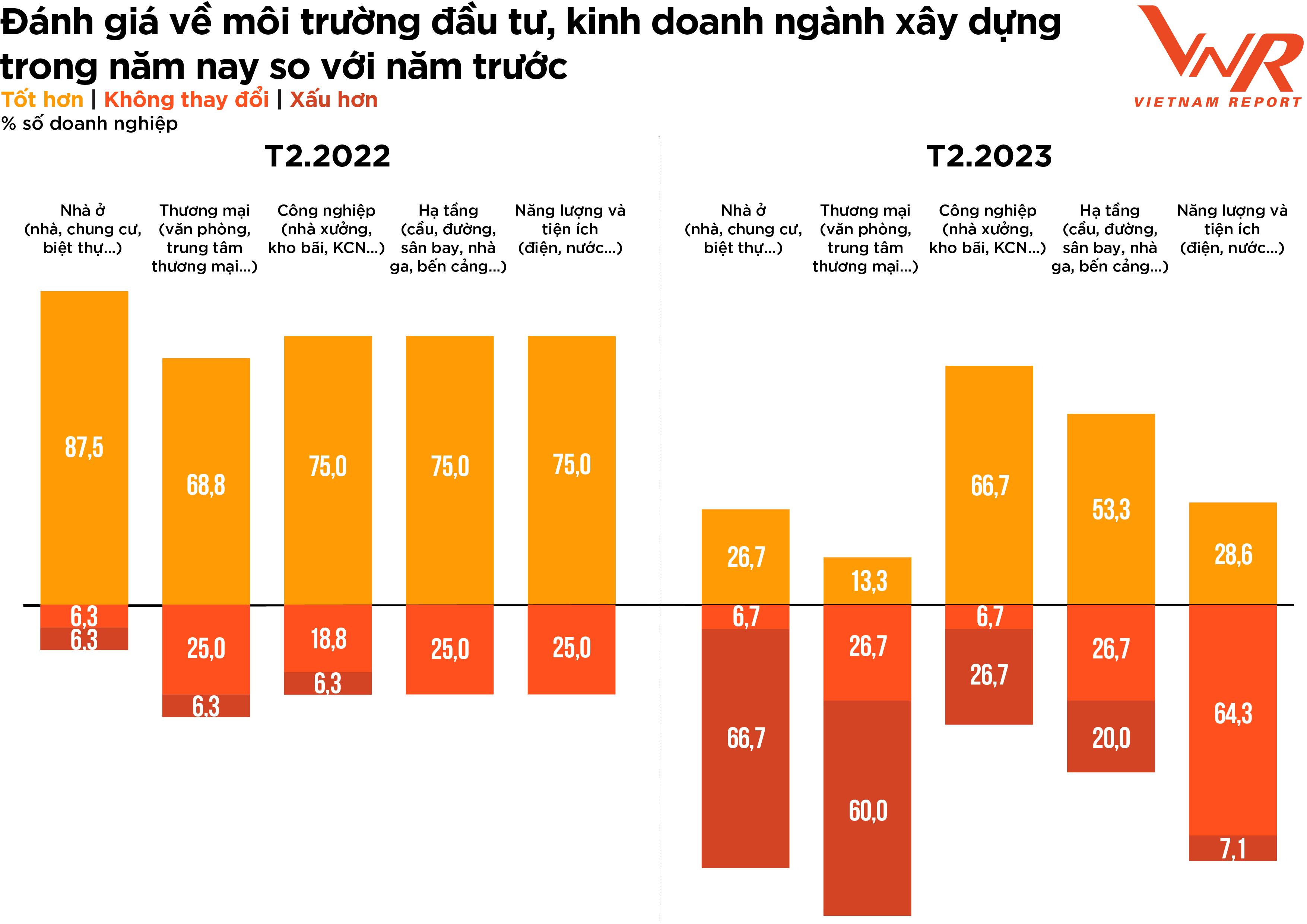
Positive signals this year come from the infrastructure and industrial construction sectors. For the group of infrastructure construction enterprises (especially highway projects), although the impact of high input costs due to materials accounting for a large proportion of total costs such as embankment soil, sand, etc., still maintains an upward price trend, it is expected to have a rebound from public investment. The period of 2023-2024 is forecast to be the peak of public investment disbursement, bringing a large source of work for infrastructure construction enterprises. In October 2022, the Ministry of Transport announced an additional investment of VND 71.7 trillion (USD 2.9 billion) in the public investment plan for the period of 2021-2025 to finance road construction. According to the General Statistics Office, in the first quarter of 2023, the realized investment capital of the state sector is estimated at VND153 trillion, up 11.5% over the same period last year. Public investment capital is forecast to increase in the coming time, which can create recovery momentum for many businesses.
According to a report from the Vietnam Association of Construction Contractors (VACC), construction enterprises in 2022 recorded a decrease in work volume, except for industrial construction - accounting for 10% - which remained stable. In the picture of 2023, industrial construction will still be a bright spot supporting the growth of the entire industry, with 66.7% of enterprises placing their faith in a brighter outlook.
In the coming time, steel/galvanized steel materials, which account for a high proportion in the cost structure of industrial construction, are gradually stabilizing, and the profit margin of enterprises in this sector is expected to improve when contracts with suppliers are adjusted according to new unit prices. In addition, the driving force comes from the booming demand for factory construction and industrial park infrastructure. The global production network is still shifting and in recent years, Vietnam has emerged as a leading destination for global companies to set up their industrial and production facilities as many leading corporations have affirmed their commitment to invest more in our country.
Figure 7: Opportunities to contribute to the growth of construction enterprises
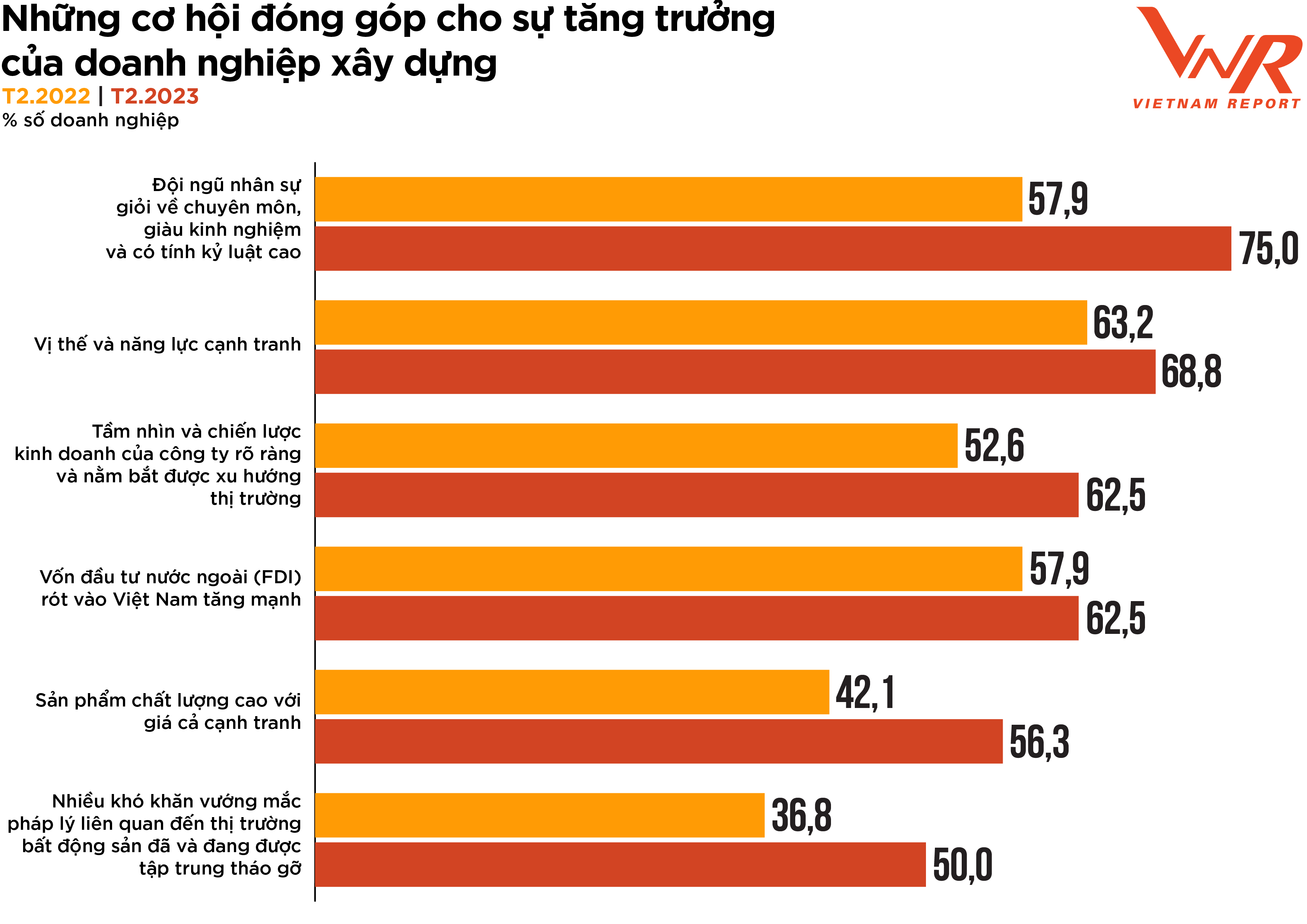
Vietnam Report's survey pointed out 6 opportunities to promote construction activities this year, including: (1) A team of highly skilled, experienced and disciplined personnel; (2) Position and competitiveness; (3) The company's vision and business strategy are clear and grasp market trends; (4) Foreign direct investment (FDI) pouring into Vietnam is increasing sharply; (5) High-quality products with competitive prices; and (6) Many legal difficulties and problems related to the real estate market have been and are being focused on resolving (Figure 7). In particular, the factor of a team of highly skilled, experienced and disciplined personnel is considered the most important driving force for the industry's growth, and is also the factor with the highest rate of enterprises choosing compared to 2022 (+17.1%). With the characteristic of using a large number of laborers in the economy, the quality of human resources is decisive for the development and success of construction companies. Having a skilled and highly specialized labor force is essential to complete projects on time, within budget and meeting required standards, thereby improving labor quality will directly affect the performance of construction enterprises in terms of productivity, efficiency and profit.
Construction has been one of the sectors that has attracted the most foreign direct investment (FDI) in recent years, so two-thirds of construction enterprises continue to expect FDI to be a driving force supporting the overall development of the entire industry in the coming time. In mid-February 2023, the Foreign Investment Agency under the Ministry of Planning and Investment reported that Vietnam is likely to attract VND831.1 to VND877.3 trillion (US$36 to US$38 billion) in FDI in 2023 – up from VND287.7 trillion (US$27.7 billion) in 2022, further strengthening the growth confidence of construction enterprises amid the difficulties.
Expect to proactively break through and shape the construction market in the new economic cycle
Looking back on the past, it can be seen that the impacts such as COVID-19, credit tightening, new production technology or digitalization, new material technology... have been and are making the entire construction industry as well as each enterprise gradually "transform" with a completely new look, becoming stronger and more durable. As an industry that is often in a passive position because cash flow, goods sources, profits... depend heavily on partners, at the present stage, construction enterprises are increasingly proactive to be able to save themselves and affirm their reputation with investors, customers and stakeholders.
On a scale of 5, businesses in the industry rated the importance of building resilience when implementing projects and allocating their business capital at 4.5 points - a very important level, an increase of 0.3 points compared to last year's survey results.
Assessing the level of commitment of construction enterprises to improve their resilience when implementing projects and allocating capital in the face of future disruptions, a positive signal was seen when the proportion of enterprises in the planning stage shifted to those in the process of improvement and completed (Figure 8).
Figure 8: Level of commitment to improving resilience to future disruptions/shocks
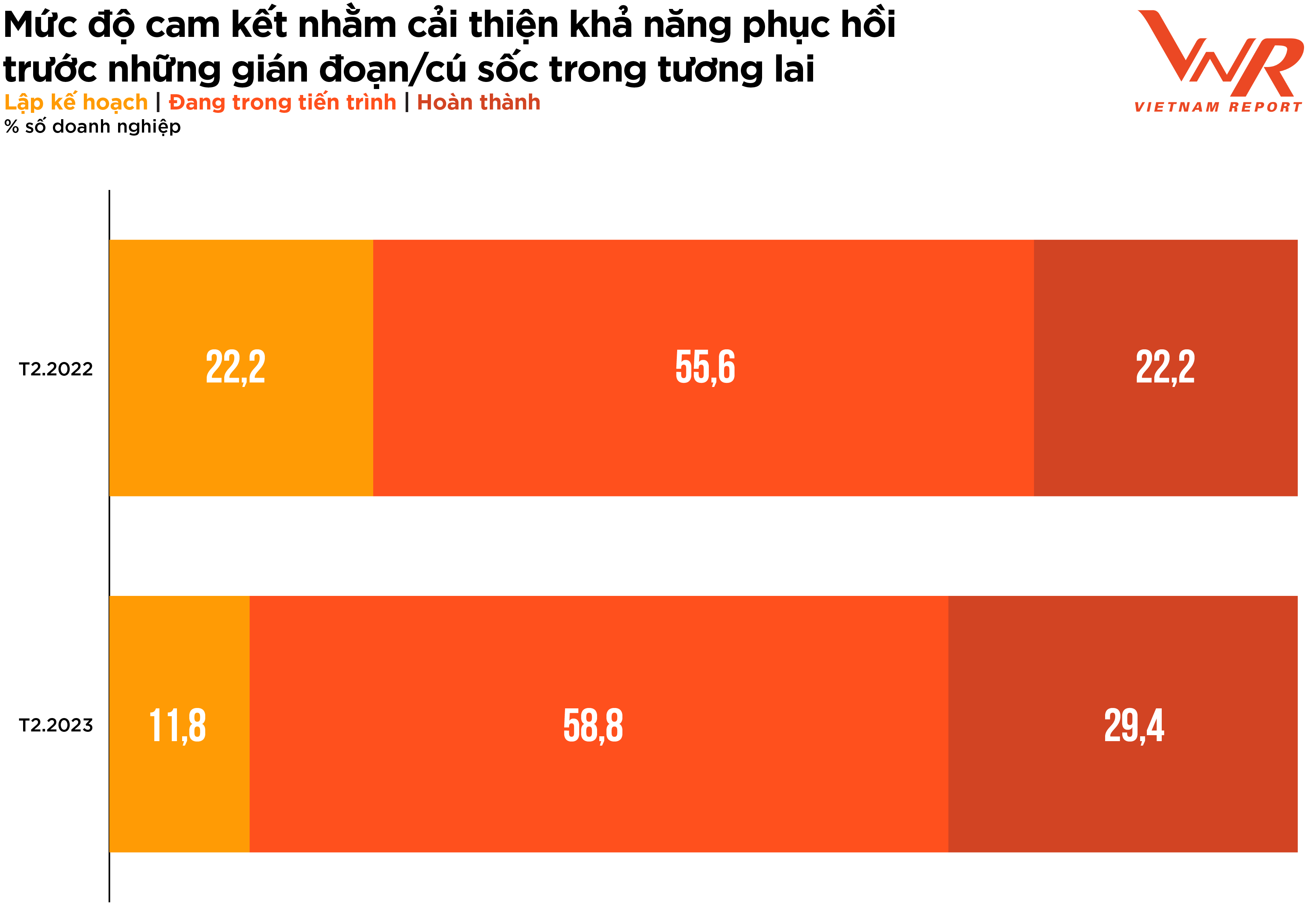
Vietnam Report’s survey results indicate seven priority solutions for construction enterprises in the short and medium term (Figure 9). Five of the seven priorities are part of efforts to improve business resilience (risk management, financial management, and human resource management).
Figure 9: Top 7 priority solutions of construction enterprises
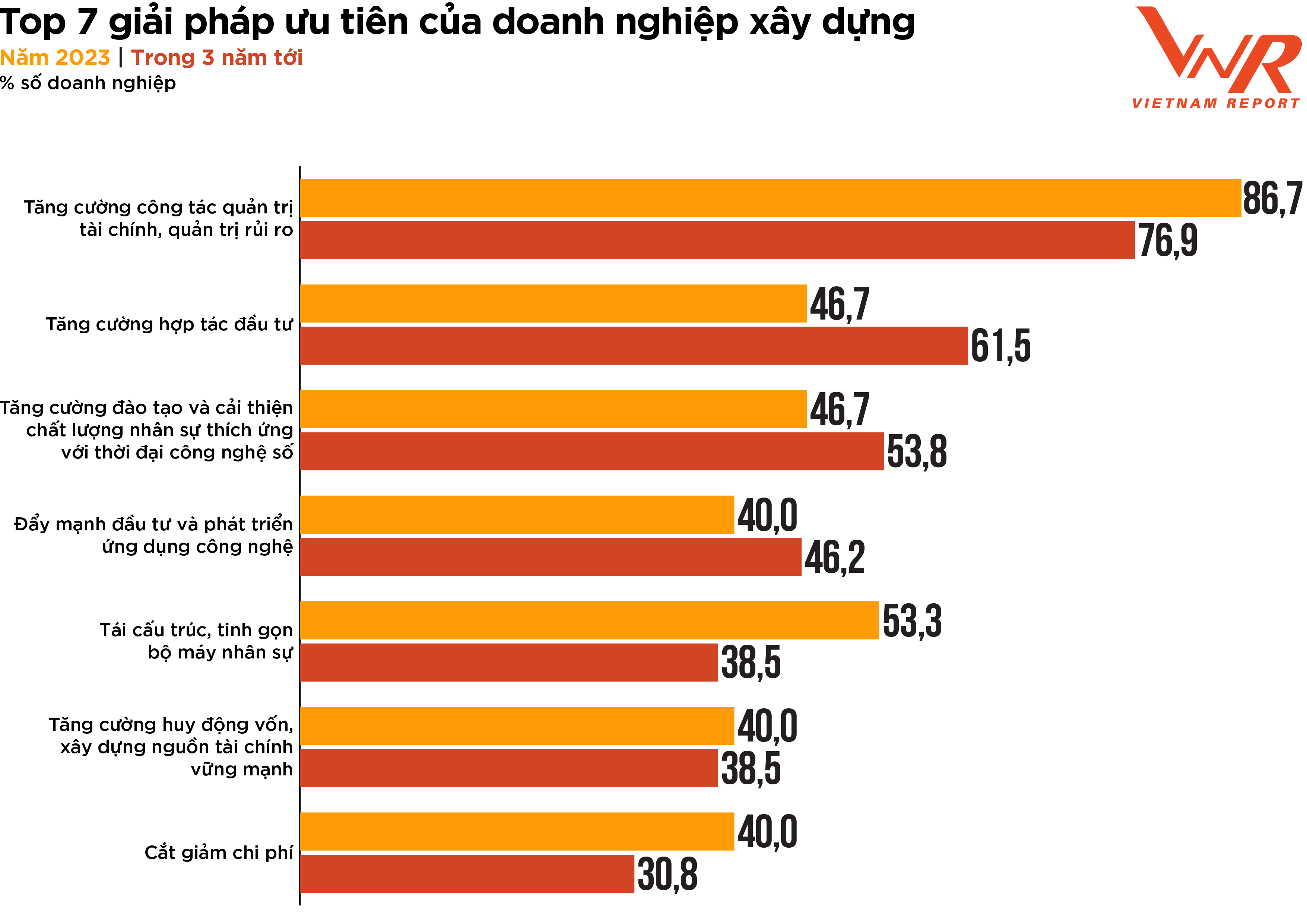
Unlike other industries, projects in the construction industry are often complex and involve multiple stakeholders. Planning, organizing, controlling and monitoring a company’s financial resources to ensure that they are allocated appropriately, projects are completed on time and within budget, and cash flow is effectively managed throughout the project life cycle. At the same time, effective risk management is also important in the construction industry, where projects are often subject to many risks, such as delays, design changes, etc. Effective risk management can help identify and mitigate these risks, reducing the likelihood of delays, cost overruns and legal disputes. In the context of a tight economy, liquidity in the real estate and construction market remains low as it is now, financial management and risk management capacity has become the top priority of construction enterprises, with the expectation of helping enterprises improve their competitiveness in the industry as well as enhance their reputation with customers and investors, while better managing their resources, reducing waste and maximizing profits.
In addition, the solution of Strengthening Investment Cooperation was chosen by 46.7% of construction enterprises to overcome current difficulties and promote development, and the number of choosing this solution for the next 3 years recorded a significant increase (+14.9%). This is an important strategy for construction enterprises that want to grow and develop in an increasingly competitive market. Construction enterprises can attract more investors and partners, including private equity firms, venture capitalists and institutional investors. By leveraging the resources, expertise and capital of external partners, construction enterprises can expand their scale, improve profitability and reduce risks.
Technology-related solutions continue to be a priority for many construction businesses. Multidimensional pressure forces businesses to seek innovative solutions to optimize operations to optimize costs and resources. Technological innovation to improve efficiency and increase productivity is a trend that will be popular and develop strongly in 2023, with the top 5 technologies that construction businesses assess as having the potential to bring the greatest return on investment (ROI) including: Building information modeling (BIM), Using advanced data analytics, Mobile platforms, Using basic data analytics, Robotic automation/digital labor processes. Most technologies have an increased rate of choice by construction businesses compared to the 2022 survey results. Of which, Building information modeling (BIM) has the strongest growth trend (+81.4%). BIM is a technology that creates and manages digital features to optimize the design, construction and operation of buildings. It has changed the way construction businesses approach design, planning, construction and maintenance. It will improve collaboration, efficiency, quality, sustainability and safety, leading to better project outcomes and improved competitiveness for construction businesses.
Since the beginning of the year, many conferences have been held with a series of support programs and incentives for the development of the construction industry by the Government in 2023, public investment capital is forecast to increase in the coming time and positive signals from FDI, which can create recovery momentum for many businesses. However, from forecast to reality is still not a matter of one day and not many businesses have the initiative to seize opportunities in the market. Entering a new phase with many new challenges but also promising more opportunities. "Fire tests gold, hardship tests strength", if overcoming the current stage when the market is screening, reputable contractors with good resilience and solid financial capacity will have the opportunity to boost profit growth more than ever.
Vietnam Report
Source






















































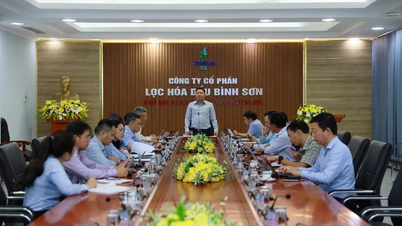




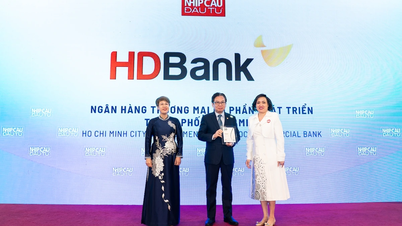











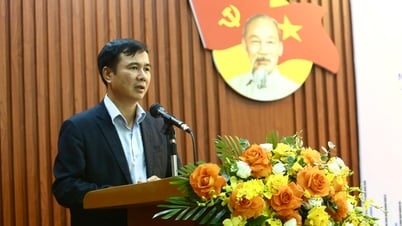




























Comment (0)